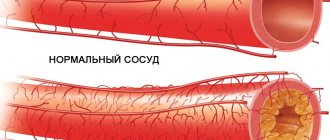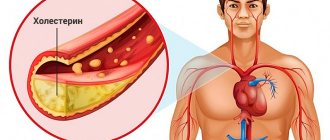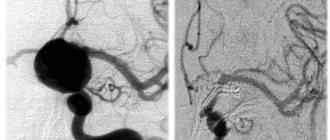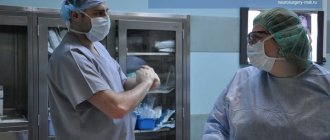Published: 07/23/2021 14:15:00 Updated: 07/23/2021
Atherosclerosis is a systemic disease that primarily affects the arteries. Cholesterol is deposited in the walls of blood vessels, resulting in the formation of plaques that interfere with normal blood flow. Internal organs experience a lack of oxygen and nutrients, and with the slow progression of the pathology, their work is gradually disrupted. In the case of acute thrombosis with complete blockage of blood flow, severe complications may develop - myocardial infarction, stroke, gangrene of the lower extremities and other dangerous pathologies.
Reasons for appearance
The appearance of atherosclerosis is associated with metabolic disorders in the body, lipid imbalance and excess cholesterol in the blood.
Mechanical damage to the vessel wall also plays an important role, contributing to atherosclerotic deposits and plaque formation at the site of injury. The risk of developing atherosclerosis is higher in men over 45 years of age, women over 55 years of age or with early menopause, as well as among people with familial hypercholesterolemia and family history, whose relatives already suffer from this disease.
Other factors contribute to it:
- unbalanced diet with an abundance of fatty foods;
- excess body weight;
- smoking;
- alcohol abuse;
- sedentary lifestyle;
- cardiovascular diseases – ischemic heart disease, arterial hypertension;
- endocrine pathologies, in particular diabetes.
Is it possible to treat cerebral atherosclerosis with folk remedies and how successful is it?
The danger of cerebral atherosclerosis lies in the high risk of deterioration of cerebral circulation.
Complications associated with this lead to “senile dementia”: forgetfulness, gradual loss of short-term and then long-term memory, disturbance of spatial orientation and time boundaries, personality disorder of the psyche. Timely drug treatment aimed at normalizing lipid metabolism, blood pressure, and cerebral circulation prevents the consequences of the disease. It is worth remembering that herbal medicine can only help at the initial stage of the disease. When choosing alternative medicine regimens, take into account that:
- the effectiveness of herbal remedies is lower than that of drugs;
- when using a mixture of herbs, there is a high risk of side effects due to individual intolerance or allergies;
- tinctures and extracts with alcohol or alcohol are contraindicated for diseases of the gastrointestinal tract, liver, gastritis, esophagitis, peptic ulcer;
- normalization of body weight and metabolism plays a key role in the treatment of atherosclerosis;
- when choosing herbal remedies, pay attention to which formulations are more effective for metabolic disorders and high cholesterol;
- in addition to taking herbal remedies, all patients are prescribed a diet with limited fat intake and a decrease in daily calorie intake;
- Without examination by a doctor, it is impossible to assess the success of the chosen treatment;
- if therapy with alternative medicines is not effective enough, progressive atherosclerosis with complete blockage of the vessel leads to a sudden circulatory disorder, stroke.
Classification of the disease
The formation of atherosclerotic plaques can occur in individual vessels or affect most of them. Depending on the organ in which blood flow is reduced and the affected artery, the following forms of the disease are distinguished:
- Heart shape. Ischemic atherosclerosis with damage to coronary vessels and valves.
- Kidney form. The renal arteries are affected.
- Brain (cerebral) form. The disease spreads to intracranial vessels.
- Intestinal form. The mesenteric arteries are affected.
- Atherosclerosis of the aorta. Its abdominal region is most often affected.
- Atherosclerosis of the arteries of the lower extremities, mainly femoral.
- Atherosclerosis of brachiocephalic vessels. These include the right carotid, vertebral and subclavian arteries.
Where can I buy
Treatment of atherosclerosis requires properly prepared herbs and other natural ingredients. It is best to buy such products in a trusted Russian Roots store. Orders from the online store are sent by mail to Moscow and the Moscow region, and by mail to other regions of the country.
There is also a whole network of herbal pharmacies “Russian Roots” in the capital.
Attention! All materials published on our website are protected by copyright. When re-publishing, attribution and a link to the original source are required.
Symptoms of atherosclerosis
For years and even decades, the disease can occur without clinical manifestations.
Subsequently, signs of poor blood supply to various organs are observed. With atherosclerosis of the heart, the patient is bothered by “squeezing” pain behind the sternum during physical activity - angina pectoris, arrhythmia, a feeling of palpitations accompanied by shortness of breath, and the development of myocardial infarction is possible.
In case of damage to the abdominal vessels, there may be attacks of pain in the upper and middle parts of the abdomen, which are accompanied by increased gas formation and constipation.
Atherosclerosis of the cerebral arteries manifests itself in dizziness and short-term episodes of loss of consciousness, and tinnitus. As the disease progresses, a stroke may develop with its neurological symptoms - dizziness, headache, lack of coordination and disorientation, numbness or weakness of the muscles of the face, arms or legs of one side of the body, sudden speech disturbances, visual disturbances, prolonged unconsciousness.
Vascular thrombosis of the lower extremities can lead to numbness and discoloration of the skin of the legs, a crawling sensation, and muscle pain when walking - “intermittent claudication.” Subsequently, the skin becomes thin and dry, peels, nails thicken, difficult-to-heal trophic ulcers form, and frequent cramps appear.
The main symptom of renal artery disease is an uncontrolled increase in blood pressure, leading to drug-resistant hypertension.
The main causes of noise in the head in older people
The question “What causes noise in the head in the elderly” is extremely relevant - every day it is asked to doctors by both the elderly themselves and their caring relatives. This symptom can be caused by both physiological, age-related changes in the human body, and a number of pathologies that he may suffer from. Many people over 60 years of age have a whole bunch of diseases, some of which may be accompanied by discomfort and unpleasant sounds in the head.
Shpidonov Gennady Stanislavovich
Neurologist
Rostov State Medical University (neurology)
10 years of experience
Atherosclerosis of cerebral vessels (cerebral atherosclerosis)
Atherosclerosis is a chronic, steadily progressing disease, which is based on a violation of lipid metabolism in the body. It is characterized by the formation of fat deposits on the walls of arteries - lipid plaques. This process leads to a narrowing of the blood vessel, which means that the tissues to which blood flows through it do not receive enough nutrients and oxygen - they experience hypoxia.
If the arteries of the heart are affected, angina pectoris develops. In cases where the pathological process affects the vessels of the brain, the patient develops the corresponding symptoms:
- headache;
- dizziness;
- tinnitus (at first transient, occurring only during intense mental activity; as the disease progresses, it becomes constant and disturbing even at rest and when trying to sleep);
- memory impairment (the patient remembers perfectly well what happened many years ago, but tries unsuccessfully to remember the events of recent minutes, hours, days);
- speech impairment (it becomes unclear, blurred, the patient forgets words), handwriting;
- sleep disturbance (difficulty falling asleep, frequent awakenings at night, early awakenings in the morning) and so on.
Atherosclerosis of cerebral vessels is the main cause of ischemic stroke, a disease with a high mortality rate. Therefore, when the first signs of this pathology appear, the patient should consult a doctor for examination and receive treatment recommendations.
Blood pressure (hypertension, hypertension, increased blood pressure)
Persistently elevated blood pressure (hypertension) and cerebral atherosclerosis, against which it arose, lead to insufficient blood supply to the brain tissue, structures of the inner and middle ear. This is what provokes the appearance of a buzzing, ringing noise in the head, the intensity of which increases with a sharp increase in pressure - a hypertensive crisis.
In addition to this symptom, hypertension can manifest itself in others, such as:
- dyspnea;
- feeling of heartbeat;
- pain in the heart area;
- headache;
- weakness.
However, in some cases, pressure increases almost asymptomatically and unpleasant sounds in the head become almost its only manifestation.
Thyroid problems
In some cases, the underlying cause of tinnitus is an endocrine problem - decreased thyroid function, or hypothyroidism. It is a frequent companion to a disease called autoimmune thyroiditis (more common in women), and also develops in people who receive insufficient amounts of iodine in their diet. Elderly people, especially those living independently, often eat an unbalanced diet, not consuming, among other things, the required amount of iodine-containing foods.
Ringing in the ears is not the only manifestation of hypothyroidism; it can also be accompanied by the following symptoms:
- weakness, fatigue;
- sleep disorders;
- hair loss;
- decreased appetite;
- stool disorders (tendency to constipation);
- low mood, reluctance to do anything;
- convulsions;
- hearing impairment;
- imbalance.
Cervical osteochondrosis
Previously, it was believed that noise in the head - constant, monotonous, both low and high frequency - most often indicates osteochondrosis of the cervical spine, pathology of the intervertebral discs, and a violation of the normal, physiological position of the vertebrae. It was indicated that with these pathologies, the blood vessels carrying blood to the brain are compressed, which is why the blood supply to the brain deteriorates and a number of problems arise, including the symptom we are describing.
Shpidonov Gennady Stanislavovich
Neurologist
Rostov State Medical University (neurology)
10 years of experience
According to the latest scientific data, the spine is an extremely stable structure, and the vertebral arteries are well protected in the spinal canal and are not easily damaged. It has been proven that osteochondrosis and most other diseases of the spinal column and neck cannot cause noise in the head. Therefore, if you have such a symptom, you should not blame osteochondrosis, but should start looking for the real cause of the deterioration of the condition in order to rid yourself of it.
Stress
In contrast to the previous point, psycho-emotional stress is a very common cause of noise in the head in older people, the treatment of which in some patients simply consists of proper rest, while in others it requires consultation with a psychiatrist and medication.
Thus, anxiety-depressive disorders, somatoform autonomic dysfunction are often accompanied by ringing and other noises in the head, as well as:
- various complaints of pain in the heart, stomach, intestines (provided that during an examination by a somatic doctor no organic pathology was identified that could cause such symptoms);
- weakness, fatigue;
- sleep disturbance;
- decreased appetite;
- feelings of anxiety, inner restlessness, inexplicable excitement, fear;
- low mood, reluctance to do anything;
- irritability, tearfulness;
- lack of initiative.
If such symptoms, including noises in the head in old age, arose after emotional stress, an acute or chronic stressful situation and do not go away within several weeks, do not be shy and wait, but should seek help from a psychiatrist.
Injuries
Open and closed head injuries often lead to tinnitus. As one of the symptoms, it will occur when:
- skull fracture at the level of the temporal bone, middle and inner ear;
- hemorrhage into brain tissue;
- damage to the central auditory pathway;
- traumatic injury to the midbrain.
The most common mechanism for such an injury is a blow to the back of the head, as in a fall on the back, which is not uncommon among older people. And in this situation, the victim notes the presence of other complaints:
- nausea;
- headache, dizziness;
- decreased or complete loss of hearing;
- unsteadiness, imbalance.
Relatives who were present at the time of injury will report the fact of a short-term loss of consciousness (but this is not a mandatory sign), and may also detect bleeding from the external auditory canal of the victim.
The noise as a consequence of a traumatic brain injury is usually intense, monotonous, and, together with other symptoms, significantly worsens the condition of an old person.
If the injury was serious, it can manifest itself even decades later, causing headaches, dizziness, and chronic buzzing in the ears and head.
Other reasons
These for old people are:
- infectious diseases of the paranasal sinuses (sinusitis);
- inflammatory processes in the ear (otitis, mastoiditis and others);
- hearing loss of any etiology;
- cerumen plug in the external auditory canal;
- foreign bodies stuck in the ear canal;
- benign and malignant tumors of the ear, brain;
- acoustic trauma (from a loud explosion or listening to very loud music);
- work in conditions of increased noise (in production facilities where devices are installed that produce a constant monotonous sound);
- taking certain medications that have a toxic effect on the organ of hearing (antibiotics, cytostatics, etc.);
- dental problems (pathology of the temporomandibular joint);
- anemia.
Factors that aggravate the situation are non-compliance with work and rest schedules, smoking, alcohol consumption, and unbalanced diet.
Diagnosis of atherosclerosis
The diagnosis is based primarily on the results of laboratory tests and data from instrumental research methods.
A conversation with a patient only allows us to identify risk factors for the development of diseases and, together with an examination, as well as consultation with other specialists, suggest which organs have already been affected by the disease. Diagnosis of atherosclerosis necessarily includes:
- Blood chemistry.
- Ultrasound of the heart and blood vessels.
- Electrocardiography.
A high predisposition to the development of the disease is indicated by changes such as an increase in the concentration of total cholesterol, triglycerides, low- and very low-density lipoproteins, and a decrease in the amount of high-density lipoproteins.
Innovative risk factors for atherosclerosis include C-reactive protein (CRP), apolipoproteins A1 (apoA1) and B-100 (apoB), some polymorphisms of endothelial synthase genes (NOS3G894T, NOS3T(-786)C) and blood coagulation factors FV and FII. To obtain accurate results of a blood test for atherosclerosis, three days before the test you should give up fatty, cholesterol-rich foods, and 8-10 hours before, eat nothing at all and drink a lot of liquid. 30 minutes before the test, you should avoid strong emotional stress, stress, and do not smoke.
Echocardiography clearly shows signs of atherosclerosis of the heart valves and aorta. According to indications, ultrasound scanning of the brachiocephalic, transcranial, and arterial vessels of the lower extremities is also performed.
Reflects disturbances in heart rhythm and electrical conductivity of the organ. Exercise testing may be performed to detect exertional angina.
The standard list of laboratory tests also includes a general clinical blood test and a general urinalysis.
Additionally, for the purpose of differential diagnosis, blood tests for the level of fibrinogen, homocysteine, antibodies to cardiolipin (IgG and IgM), and lupus anticoagulant may be recommended. To visualize atherosclerotic plaques, according to indications, angiography is used - an X-ray examination with the introduction of a contrast agent. In case of preparation for surgery on the heart vessels, coronary angiography is performed.
The “gold standard” for diagnosing pathological changes in the arteries of the brain and parenchymal organs is spiral computed tomography with contrast.
Often such patients are recommended to consult an ophthalmologist. Fundus ophthalmoscopy reveals signs of atherosclerotic damage to small retinal vessels.
What traditional medicine methods are effective?
To treat cerebral atherosclerosis at home, it is necessary to take into account their spectrum of action when choosing herbal remedies. The most recommended are herbal preparations with a lipid-lowering effect, which reduce the formation of harmful lipoproteins, speed up metabolism and remove cholesterol from the body. Herbs help improve fat metabolism, reduce the manifestations of vascular spasm and increase their tone, prevent blood thickening, and contain vitamins and minerals.
The most popular recipes are:
- A teaspoon of dry lemon balm, mint, nettle leaves and strawberries is poured into 400 ml of boiling water, left for 60-90 minutes and filtered. The resulting infusion is drunk a glass a day for two to three weeks. After a break of five days, the course is repeated if desired.
- Pour 300 ml of boiling water over a tablespoon of dried burdock and dill leaves and leave for an hour. Consume throughout the day. Course up to seven days.
- 5-10 g of dry leaves of coltsfoot, hawthorn, mint and lemon balm, pour 500 ml of boiling water, let it brew for 2-3 hours. After straining, drink the infusion half a glass before lunch and dinner for a week. After a break of five days, repeat the course.
- Pour a teaspoon of dried strawberries and rose hips, mint leaves and lemon balm into 400 ml of boiling water and leave in a warm place for half an hour. After straining, drink 150 ml before meals. It is recommended to take seven to ten days.
- For the decoction, mix a tablespoon of rose hips, strawberries, lingonberries, peppermint leaves and lemongrass, add 4 cups of warm water and simmer over low heat for 10-20 minutes. Then leave for another 20 minutes. and strain. Drink the drink 50-100 ml per dose before or after meals for 10-15 days. After a break of a week, repeat.
Multicomponent preparations are recommended to continue the course of treatment. To prepare a herbal drink, take equal parts of dry ingredients (10 g), pour 300-400 ml of boiling water, heat over low heat and leave for 1-2 hours in a warm place. The course of treatment is two to four weeks for six months with breaks. The following components are used:
- Dried rose hips, lingonberries, rowan with strawberry and mint leaves.
- Corn silk, elecampane grass with mint and lemongrass.
- Dill, sorrel, yarrow with mint and lemon balm.
- Dried hawthorn berries, peeled raspberry and lingonberry shoots.
- Oregano, elecampane rhizomes with lemon balm.
- Two small cloves of garlic, zest and juice of one lemon.
- Dried dill seeds.
- Juice of one lemon, a teaspoon of honey and olive oil.
- Dried lemon balm leaves, lemon zest.
- Rowan bark and berries.
Also, medicinal herbs for cerebral atherosclerosis are used to prepare alcohol tinctures. Alcohol, used as a solvent, extracts all the most beneficial properties from plant materials. For each remedy, two tablespoons of pharmaceutical dry herbs are poured into 300-500 ml of 40% alcohol or vodka, and left for a week in a cool, dark place.
Unlike infusions with boiling water, you do not need to drink large volumes of liquid; 5-15 drops of the prepared strained extract are enough. Considering the irritating effect of ethyl alcohol on the mucous membrane of the gastrointestinal tract, add the concentrate to a glass of plain cool water.
The following folk remedies are used to prepare one-component alcohol infusions:
- dried clover flowers;
- Japanese sophora pods;
- dry walnut partitions;
- inflorescences and leaves of meadow clover;
- dry roots and leaves of elecampane.
Some foods are used as an alternative to treat atherosclerosis. Naturopathic experts recommend the following recipes:
- To prepare a horseradish decoction, rub the peeled dry rhizomes on a fine grater, pour 2 liters of boiling water and leave for 40 minutes. After filtering, the warm drink is consumed 30-50 ml before meals for 2-4 weeks.
- A similar decoction is prepared from the leaves and stems of parsley and dill.
- Garlic is effective in the fight against atherosclerosis - the cloves are added to food, or the resulting juice is mixed with a spoonful of honey and consumed before meals for a month.
- Onion juice mixed with a spoonful of honey and lemon juice helps normalize metabolism.
- To prevent atherosclerosis, it is useful to drink freshly squeezed juices from currants, lingonberries or cranberries.
- Food products include kelp, beets, radish and carrot salad.
- It is recommended to include green salads and fresh cabbage in your meals.
- Dairy products are chosen with low fat content (up to 10%).
- Fatty meat is replaced with sea fish.
- Green and herbal teas are beneficial.
In order for therapy with herbal preparations to lead to positive results, they are treated for a long time (more than two to four months). However, side effects develop from the use of tinctures and decoctions, since frequent intake of berries and herbs affects the level of acidity of gastric juice, which manifests itself:
- discomfort in the stomach or intestines;
- exacerbation of gastritis;
- indigestion, diarrhea;
- unpleasant taste in the mouth;
- sour belching;
- nausea, heaviness in the epigastric region.
Tinctures and extracts containing alcohol are contraindicated:
- women during pregnancy;
- children;
- with unstable blood pressure;
- vegetative-vascular dystonia of the hypertensive type;
- diseases of the gastrointestinal tract;
- liver pathologies.
Treatment
Treatment of atherosclerosis begins with correction of diet and lifestyle changes.
All patients are recommended to lose weight, moderate physical activity, and quit smoking and alcohol. Often the cause of atherosclerosis is a nutritional factor, so diet plays a very important role. To reduce the concentration of cholesterol in the blood, it is important to avoid meat broths, fatty, salty, smoked foods, semi-finished products, spicy, spicy, fried foods, and limit the consumption of table salt.
Prohibited products include:
- sugar;
- confectionery, sweets;
- mayonnaise, tomato and other store-bought sauces;
- bakery products made from wheat flour;
- offal;
- sweet carbonated drinks;
- industrially produced juices and nectars;
- cocoa;
- canned meat and fish;
- dried fruits high in sugars;
- strong coffee and tea.
It is recommended to eat split meals five times a day, including a sufficient amount of fiber, protein (lean meats and fish, low-fat cottage cheese), fresh vegetables (except potatoes), fruits, and dairy products.
Drug therapy is aimed at:
- decreased cholesterol synthesis (statins, fibrates);
- decreased absorption of fats from food (cholesterol absorption inhibitors, bile acid sequestrants);
- prevention of thromboembolic complications (antiplatelet agents);
- relief of symptoms of atherosclerosis (painkillers, antispasmodics).
To determine indications for surgical treatment, the degree of disruption of blood flow in the vessel is determined.
An overlap of its lumen of less than 50% is considered hemodynamically insignificant; with stenosis of 50-70%, only drug therapy is usually carried out. Correction of arterial obstruction surgically must be performed in the third stage of atherosclerosis and narrowing of the lumen by more than 70%. There are two main types of surgical intervention:
- Balloon angioplasty. A balloon is inflated inside the affected vessel, while the atherosclerotic plaque is flattened and evenly distributed along the artery wall. At the end of the manipulation, the device is removed.
- Arterial stenting. During the operation, a thin lattice cylinder is inserted and opened in the area of narrowing. It also presses against the plaque, but remains in the lumen of the vessel, gradually growing into its endothelium.
Complications
Atherosclerosis of the lower extremities is dangerous due to the development of gangrene, muscle atrophy, and thromboembolism of blood vessels of vital organs in the event of plaque rupture.
Cardiac complications with damage to the coronary vessels include myocardial infarction, focal dystrophy of the heart muscle, myocardiosclerosis, and coronary sclerosis.
With obstruction of the mesenteric arteries, ischemic colitis and intestinal gangrene are possible, and secondary arterial hypertension is possible in the renal arteries. Cerebral consequences include hemorrhagic and ischemic stroke, transient ischemic attacks, and atherosclerotic dementia.
An aortic aneurysm poses a danger to the patient's life, the rupture of which in most cases is fatal.
conclusions
Treatment of cerebral atherosclerosis with folk remedies is rational only at the initial stage of the disease. Considering the high risk of consequences (gradually progressive cerebrovascular accident, development of senile dementia, dementia, threat of stroke), doctors strongly do not recommend resorting to alternative medicine. According to recent studies, herbal remedies are prescribed in addition to the medication regimen to improve the effect and more quickly normalize metabolism, fats and cholesterol. However, the basis of therapy is pharmaceutical drugs according to generally accepted treatment protocols in medicine.
Prevention of atherosclerosis
For patients with a family history and age-related predisposition, a screening examination is recommended to determine the risk of developing cardiovascular pathology.
It aims to detect laboratory and genetic markers of the disease. Prevention of atherosclerosis includes weight control, proper nutrition, sufficient physical activity, giving up bad habits, and timely treatment of chronic diseases.
Author:
Pugonina Tatyana Alekseevna, Therapist







